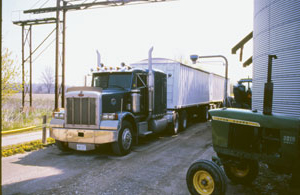
Features
Agronomy
Weeds
Give canola a fighting chance by taking out weeds early
Canola is not a fierce competitor until it covers the ground, so removing weeds early is important for preserving yield potential. “Even with the varieties and genetics we have today, canola still requires significant protection from weed competition,” explains Doug Moisey, senior agronomist, Parkland East, with the Canola Council of Canada.
October 20, 2009 By Donna Fleury
Canola is not a fierce competitor until it covers the ground, so removing weeds early is important for preserving yield potential. “Even with the varieties and genetics we have today, canola still requires significant protection from weed competition,” explains Doug Moisey, senior agronomist, Parkland East, with the Canola Council of Canada. “If seedlings emerge into weed competition at the beginning, it just sets them back and puts a lot of stress on the plant. We recommend using a pre-seed burn prior to seeding, and to remove weeds early in-crop to maximize yield potential.”
 |
|
| Canola growers tour AAFC Lacombe canola plots. Photo by Bruce Barker. |
When a grower starts seeing weed pressure show up, the earlier he can try to control the weeds, the better. “Delaying spraying, especially if weed densities are high, can be risky,” says Moisey. “Going in at the one- to two-leaf stage of the canola crop is what we’ve discovered to be the most economical and most high-yielding treatment.” This recommendation applies to any canola variety or system.
Dr. Neil Harker, weed scientist with Agriculture and Agri-Food Canada (AAFC) at Lacombe, Alberta, started conducting time of weed removal research more than 10 years ago. When growers moved away from pre-seed treatments to post-emergent herbicides, many started waiting until all the weeds were up before application, which was just too long. Harker started conducting weed removal studies in a variety of crops including canola to try to determine the best weed management strategies for maximizing yield potential. “The findings have been consistent all the way along, whether in small plot research, larger field scale studies or in talking to farmers,” explains Harker. “All of the findings confirm that early weed removal is one of the key ways to get a high yielding canola crop. The consequences of waiting can mean losing a lot of money in a hurry.”
Remove weeds by the two-leaf stage for maximum returns
Research shows that delaying weed removal until the six- to seven-leaf stage reduced canola yields by 20 percent or more. “Assuming canola prices from a low of $250/t to a high of $650/t, growers could lose $20 to $53/acre ($50 to $131/ha), respectively by delaying herbicide application from the one- to two- to the three- to five-leaf stage, or $50 to $111/acre ($106 to $275/ha), respectively, by delaying herbicide application from the one- to two- to the six- to seven-leaf stage,” explains Harker. “That adds up to significant losses in yields and net returns.”
Researchers recommend that, generally, weeds be removed before the four-leaf stage. In some clean fields, there may be few weeds at the one- to two-leaf stage, so delaying a bit longer may be warranted. However in many cases, weed removal at the one- to two-leaf stage is better than at the three- to four-leaf stage.
To achieve proper weed control and to be able to control weeds early means ensuring good crop emergence and maintaining a uniform even stand. “Establishing uniform and stable plant populations helps as the plants get older to compete against newly emerging weeds,” explains Moisey. A good stand target is eight to 10 plants per square foot or higher to achieve a good uniform plant stand.
Doing a good job at seeding time gets the crop out of the ground rapidly and evenly so when it comes time to spray, growers are not dealing with weeds at various stages. For example, with certain systems, applications must be done at a minimum of the one-leaf stage. If a field has uneven emergence, then part of the field may be at the one- to two-leaf stage, while other areas may be just emerging or at the cotyledon stage. Spray too early and there could be tolerance issues with the emerging plants. Wait too long, then the weeds are too competitive and potential yields may be reduced already.
“In talking to some of the higher yielding canola growers, there are four common and consistent things they do to get a high-yielding canola crop,” adds Harker. Pick a strong competitive variety, which typically means a hybrid. Seed early, put on a full fertility package to achieve a good even and uniform stand, and always remove weeds early.
“Growers should start planning for next year this fall,” says Moisey. “If you have the opportunity to do a pre-harvest or post-harvest application, then make sure to do it on your canola ground. If you don’t, then make sure to use a pre-seed burndown prior to spring seeding or within a couple days after seeding, depending on the system. Getting those weeds controlled early basically sets yourself up for the rest of the season.”